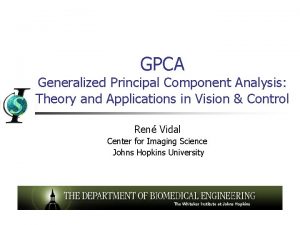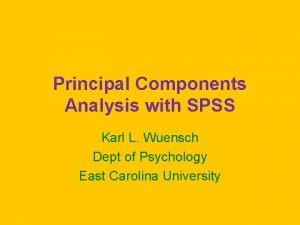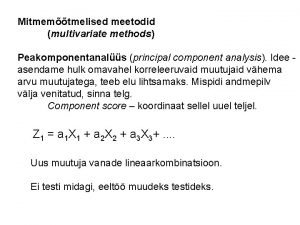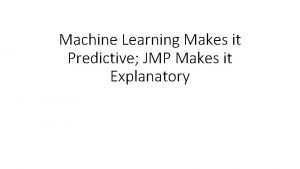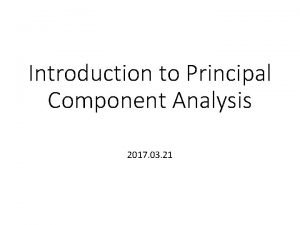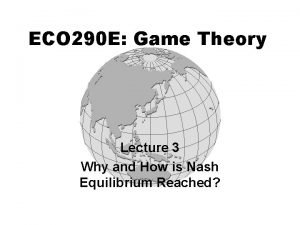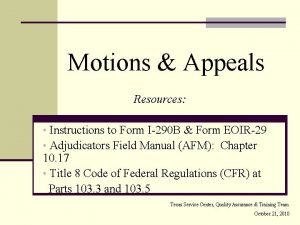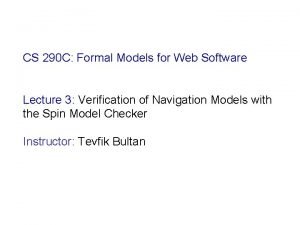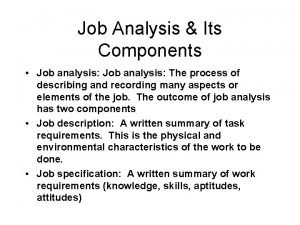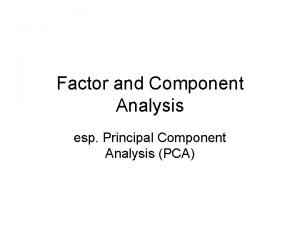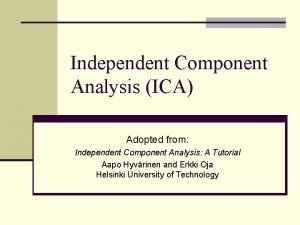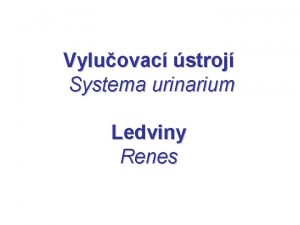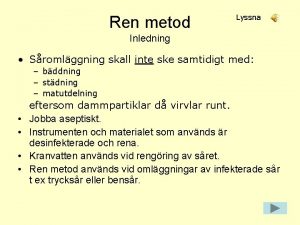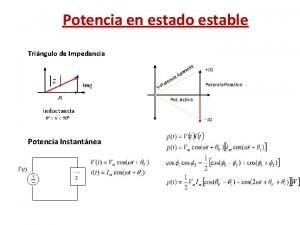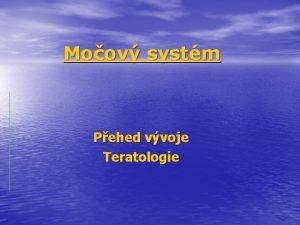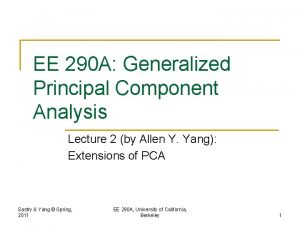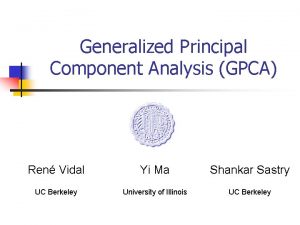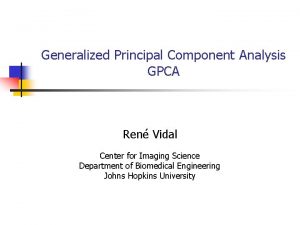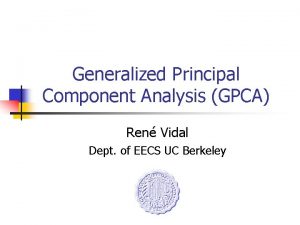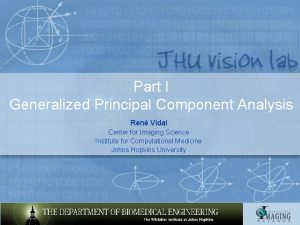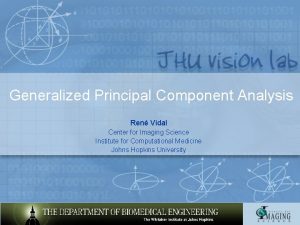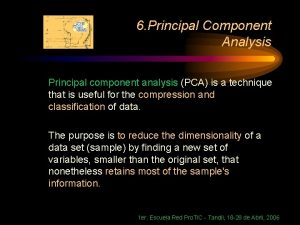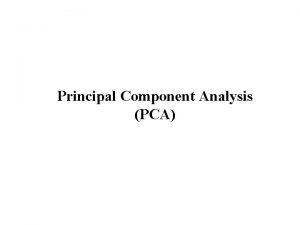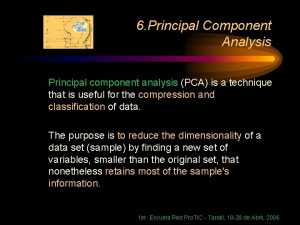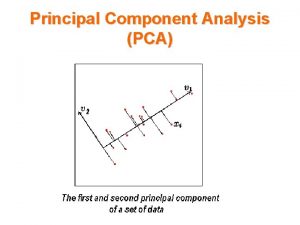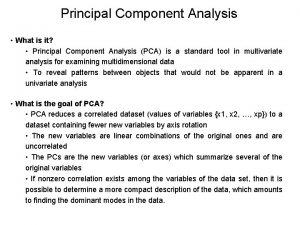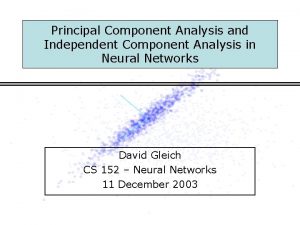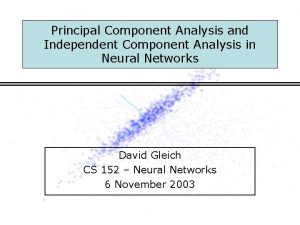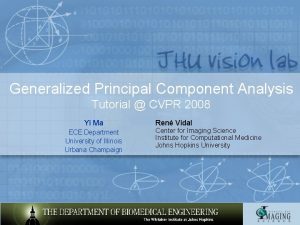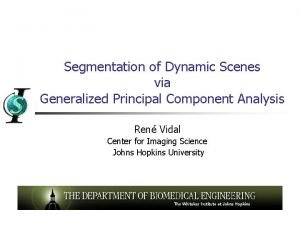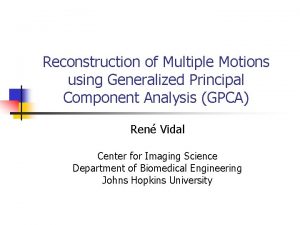EE 290 A Generalized Principal Component Analysis Ren














![Finding a basis for each subspace Polynomial Differentiation (GPCA-PDA) [CVPR’ 04] • To learn Finding a basis for each subspace Polynomial Differentiation (GPCA-PDA) [CVPR’ 04] • To learn](https://slidetodoc.com/presentation_image_h/0dcb30afbbcdf0b0d9d78bcc7268b724/image-15.jpg)











- Slides: 26

EE 290 A Generalized Principal Component Analysis René Vidal Center for Imaging Science Institute for Computational Medicine Johns Hopkins University

Principal Component Analysis (PCA) • Given a set of points x 1, x 2, …, x. N – Geometric PCA: find a subspace S passing through them – Statistical PCA: find projection directions that maximize the variance • Solution (Beltrami’ 1873, Jordan’ 1874, Hotelling’ 33, Eckart-Householder-Young’ 36) Basis for S • Applications: data compression, regression, computer vision (eigenfaces), pattern recognition, genomics

Extensions of PCA • Higher order SVD (Tucker’ 66, Davis’ 02) • Independent Component Analysis (Common ‘ 94) • Probabilistic PCA (Tipping-Bishop ’ 99) – Identify subspace from noisy data – Gaussian noise: standard PCA – Noise in exponential family (Collins et al. ’ 01) • Nonlinear dimensionality reduction – Multidimensional scaling (Torgerson’ 58) – Locally linear embedding (Roweis-Saul ’ 00) – Isomap (Tenenbaum ’ 00) • Nonlinear PCA (Scholkopf-Smola-Muller ’ 98) – Identify nonlinear manifold by applying PCA to data embedded in high-dimensional space • Principal Curves and Principal Geodesic Analysis (Hastie-Stuetzle’ 89, Tishbirany ‘ 92, Fletcher ‘ 04)

Generalized Principal Component Analysis • Given a set of points lying in multiple subspaces, identify – The number of subspaces and their dimensions – A basis for each subspace – The segmentation of the data points • “Chicken-and-egg” problem – Given segmentation, estimate subspaces – Given subspaces, segment the data

Prior work on subspace clustering • Iterative algorithms: – K-subspace (Ho et al. ’ 03), – RANSAC, subspace selection and growing (Leonardis et al. ’ 02) • Probabilistic approaches: learn the parameters of a mixture model using e. g. EM – Mixtures of PPCA: (Tipping-Bishop ‘ 99): – Multi-Stage Learning (Kanatani’ 04) • Initialization – Geometric approaches: 2 planes in R 3 (Shizawa-Maze ’ 91) – Factorization approaches: independent subspaces of equal dimension (Boult-Brown ‘ 91, Costeira-Kanade ‘ 98, Kanatani ’ 01) – Spectral clustering based approaches: (Yan-Pollefeys’ 06)

Basic ideas behind GPCA • Towards an analytic solution to subspace clustering – Can we estimate ALL models simultaneously using ALL data? – When can we do so analytically? In closed form? – Is there a formula for the number of models? • Will consider the most general case – Subspaces of unknown and possibly different dimensions – Subspaces may intersect arbitrarily (not only at the origin) • GPCA is an algebraic geometric approach to data segmentation – Number of subspaces = degree of a polynomial – Subspace basis = derivatives of a polynomial – Subspace clustering is algebraically equivalent to • Polynomial fitting • Polynomial differentiation

Applications of GPCA in computer vision • Geometry – Vanishing points • Image compression • Segmentation – – • Intensity (black-white) Texture Motion (2 -D, 3 -D) Video (host-guest) Recognition – Faces (Eigenfaces) • Man - Woman – Human Gaits – Dynamic Textures • Water-bird • • Biomedical imaging Hybrid systems identification

Introductory example: algebraic clustering in 1 D • Number of groups?

Introductory example: algebraic clustering in 1 D • How to compute n, c, b’s? – Number of clusters – Cluster centers – Solution is unique if – Solution is closed form if

Introductory example: algebraic clustering in 2 D • What about dimension 2? • What about higher dimensions? – Complex numbers in higher dimensions? – How to find roots of a polynomial of quaternions? • Instead – Project data onto one or two dimensional space – Apply same algorithm to projected data

Representing one subspace • One plane • One line • One subspace can be represented with – Set of linear equations – Set of polynomials of degree 1

Representing n subspaces • Two planes • One plane and one line – Plane: – Line: De Morgan’s rule • A union of n subspaces can be represented with a set of homogeneous polynomials of degree n

Fitting polynomials to data points • Polynomials can be written linearly in terms of the vector of coefficients by using polynomial embedding Veronese map • Coefficients of the polynomials can be computed from nullspace of embedded data – Solve using least squares – N = #data points

Finding a basis for each subspace • Case of hyperplanes: – Only one polynomial – Number of subspaces – Basis are normal vectors Polynomial Factorization (GPCA-PFA) [CVPR 2003] • • • Find roots of polynomial of degree in one variable Solve linear systems in variables Solution obtained in closed form for • Problems – Computing roots may be sensitive to noise – The estimated polynomial may not perfectly factor with noisy – Cannot be applied to subspaces of different dimensions • Polynomials are estimated up to change of basis, hence they may not factor, even with perfect data
![Finding a basis for each subspace Polynomial Differentiation GPCAPDA CVPR 04 To learn Finding a basis for each subspace Polynomial Differentiation (GPCA-PDA) [CVPR’ 04] • To learn](https://slidetodoc.com/presentation_image_h/0dcb30afbbcdf0b0d9d78bcc7268b724/image-15.jpg)
Finding a basis for each subspace Polynomial Differentiation (GPCA-PDA) [CVPR’ 04] • To learn a mixture of subspaces we just need one positive example per class

Choosing one point per subspace • With noise and outliers – Polynomials may not be a perfect union of subspaces – Normals can estimated correctly by choosing points optimally • Distance to closest subspace without knowing segmentation?

GPCA for hyperplane segmentation • Coefficients of the polynomial can be computed from null space of embedded data matrix – Solve using least squares – N = #data points • Number of subspaces can be computed from the rank of embedded data matrix • Normal to the subspaces from the derivatives of the polynomial can be computed

GPCA for subspaces of different dimensions • There are multiple polynomials fitting the data • The derivative of each polynomial gives a different normal vector • Can obtain a basis for the subspace by applying PCA to normal vectors

GPCA for subspaces of different dimensions • Apply polynomial embedding to projected data • Obtain multiple subspace model by polynomial fitting – Solve to obtain – Need to know number of subspaces • Obtain bases & dimensions by polynomial differentiation • Optimally choose one point per subspace using distance

An example • Given data lying in the union of the two subspaces • We can write the union as • Therefore, the union can be represented with the two polynomials

An example • Can compute polynomials from • Can compute normals from

Dealing with high-dimensional data • Minimum number of points – K = dimension of ambient space – n = number of subspaces Subspace 1 • In practice the dimension of each subspace ki is much smaller than K Subspace 2 – Number and dimension of the subspaces is preserved by a linear projection onto a subspace of dimension – Can remove outliers by robustly fitting the subspace • Open problem: how to choose projection? – PCA?

GPCA with spectral clustering • Spectral clustering – Build a similarity matrix between pairs of points – Use eigenvectors to cluster data • How to define a similarity for subspaces? – Want points in the same subspace to be close – Want points in different subspace to be far • Use GPCA to get basis • Distance: subspace angles

Comparison of PFA, PDA, K-sub, EM

Summary • GPCA: algorithm for clustering subspaces – Deals with unknown and possibly different dimensions – Deals with arbitrary intersections among the subspaces • Our approach is based on – Projecting data onto a low-dimensional subspace – Fitting polynomials to projected subspaces – Differentiating polynomials to obtain a basis • Applications in image processing and computer vision – Image segmentation: intensity and texture – Image compression – Face recognition under varying illumination

For more information, Vision, Dynamics and Learning Lab @ Johns Hopkins University Thank You!
 Generalized principal component analysis
Generalized principal component analysis Generalized principal component analysis
Generalized principal component analysis Karl wuensch
Karl wuensch Principal component analysis
Principal component analysis Jmp neural network
Jmp neural network Principal component analysis
Principal component analysis 30 tac 290
30 tac 290 A 290. számú auschwitzi fogoly
A 290. számú auschwitzi fogoly Eco 290
Eco 290 Form i290
Form i290 Specs 290 and jones
Specs 290 and jones Cs 290
Cs 290 Form uib-290
Form uib-290 What are the components of job analysis
What are the components of job analysis Independent component analysis vs pca
Independent component analysis vs pca Independent component analysis tutorial
Independent component analysis tutorial Ren dystopicus
Ren dystopicus Corpusculum renale
Corpusculum renale Ren nai
Ren nai Plica vesicouterina
Plica vesicouterina Ductus allantoideus
Ductus allantoideus Ren metod
Ren metod Ren descartes
Ren descartes Potencia reactiva
Potencia reactiva Fossa retro ureterica
Fossa retro ureterica Ductus allantoideus
Ductus allantoideus Wo jia you liu kou ren
Wo jia you liu kou ren

